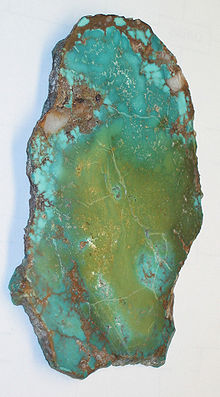The chemical composition of turquoise rock is complicated, and it can vary based on where it is mined. The chemical formula of this stone is:CuAl6(PO4)4(OH)8·4H2O.
What does this really mean? It means that turquoise rock is a combination of copper and aluminum in a phosphate base. It is an opaque stone that is fairly soft, only a little harder to scratch than window glass. Based on where turquoise is mined, it can have other metals in it, as well, which can affect the rock’s beautiful blue-green color. For example, some areas produce turquoise that contains more iron, which gives it a greener color. Other minerals in the turquoise may produce a “mottled” or “spiderweb” effect. In general, these turquoise rocks are considered less valuable than those than are pure blue. However, many people still love the look of these “less valuable” pieces of turquoise.
Turquoise rocks mined in Iran and surrounding areas tend to be a very pure blue, and sometimes they look almost translucent. On the other hand, turquoise from the southwester United States is more likely to have a green tint to it. Some Southwestern mines, like the Sleeping Beauty mine, can produce gorgeous turquoise that is only slightly greener than what is found in Iran. Sleeping Beauty turquoise is very popular and very sought-after because of its color and lack of mottling.
Turquoise can be sensitive to sunlight, dust, and cosmetics, and over time exposure to these factors may cause a stone to change color. Turquoise rocks usually become more green over time.
Turquoise rock comes from many different areas of the world, and its color and appearance reflect the soil and conditions where it was mined. No matter where it is from, turquoise makes beautiful jewelry. Some people think green turquoise is less valuable, but it is still beautiful and versatile, and it looks great with almost any outfit. If you’re trying to select an item of turquoise jewelry,
